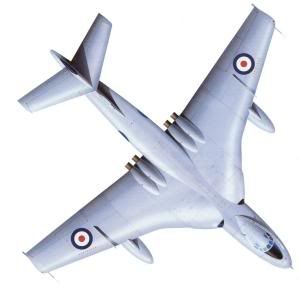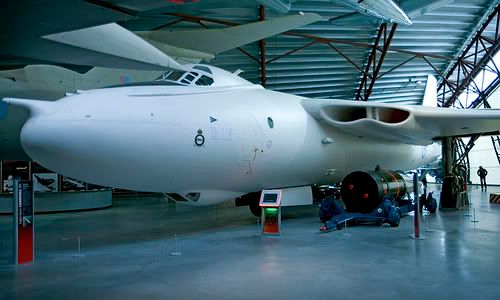1]
VICKERS VALIANT
First flew : 18th May 1951, flown by Jock Bryce & Mutt Summers
First operational : January 1955
Mk.2 first flew : 4th September 1953
End of the line : January 1965
Variants
Type 660 Prototype
B.Mk.1 First production
B(PR).Mk.1 Reconnaissance
B.Mk.2 Pathfinder target marking

VICKERS VALIANT B.Mk 1
Crew 5
Power Plant 4 10,000Ib.s.t. Rolls-Royce Avon 28 turbo fans
Span 114.33 ft (34.85 m)
Length 108.25 ft (32.99 m)
Wing area 2,362 sq ft (219.4 m2)
Weight empty 75,881 Ib (34.419 kg)
MTOW 140,000 Ib (63,503 kg)
Maximum speed 492 knots at 30,000 ft
Ceiling 54,000 ft (16,459 m)
Range 3,908 naut. miles (7,242 km)
Unrefuelled load Up to 21,000 Ib (9,525 kg)
A Valiant B1 was the first RAF aircraft to deliver an operational British atomic bomb in a test of a down-rated Blue Danube weapon at Maralinga, South Australia, on 11 October 1956. The Valiant was the first of the V-bombers to see combat, during the Anglo-French-Israeli Suez intervention (Op. Musketeer) in October-November 1956. Valiants were originally assigned to the strategic nuclear bombing role as were the Vulcan and Victor B1s when they became operational. Originally the bombing role was at high level but with the shooting down of Gary Powers' U-2 in 1960, the SAM threat caused the V-force to train for low-level attack. They were repainted in grey/green camouflage, replacing their anti-flash white scheme. Low-level operations proved too much for the Valiant, which suffered from metal fatigue issues in 1964. In early 1965 the government decided repairs could not be justified and the fleet was permanently grounded.

The last known Valiant bomber sortie was on 9 December 1964 in XD818, the aircraft pictured above, which is housed at the RAF Museum at Cosford in Staffordshire as the last example of these aircraft. Under the wing is an example of Yellow Sun, the first British operational high-yield strategic nuclear weapon. The casing was 6.4m long, 1.2m in diameter, and weighed 3.3 tonnes. Unlike contemporary US bombs it did not use a parachute to retard its fall; instead, the blunt nose was intended to slow the fall of the weapon sufficiently to permit the bomber to escape the detonation. The initial Green Grass warhead was originally estimated to have a 500 kT yield , but this was later revised downwards to 400 kT. It was never tested. It used a dangerously large quantity of fissile material, considerably more than an uncompressed critical mass. It was kept subcritical by being fashioned into a thin-walled spherical shell. To guard against accidental crushing of the core into a critical condition the shell was filled with 133,000 steel ball-bearings weighing 450 kg. These had to be removed before flight.

